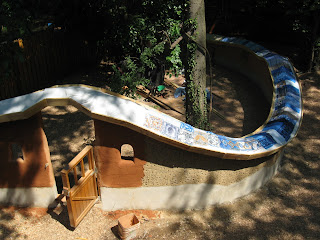As I approached the field, I couldn't quite decipher the hairy blob sitting alone in the middle of it. An animal? A big ball of cob? An enormous ball of snow holding out from our wintry weekend earlier this month?
The stove pipe exits the NE corner of the building which is, ironically, where the icicles form. That awkward hole will be re-filled with cob and plaster someday.
I had some fun with the interior plastering last month. Here's the branch:
.... and here's the trunk. It went from being an abstract shape (that Elizabeth thought looked too much like cartoon side-burns) to a possible bird swooping in, to a snake head, to a tree.
Sinking bricks into the finished floor:
Floating pieces of slate atop the bricks:
A magical pad for the wood stove! Hovering, like a shaman might do.
Some finish trim at the top edge of the window to close up the 1/4" gap (that had been left to allow the house to settle without stressing the glass):
And here's the "double-boiler-with-a-lid" setup that we devised to heat our linseed oil for the final floor durability treatment. I've applied one layer of oil to the floor - three more coats tomorrow, each getting more and more thinned out with mineral spirits.


















































